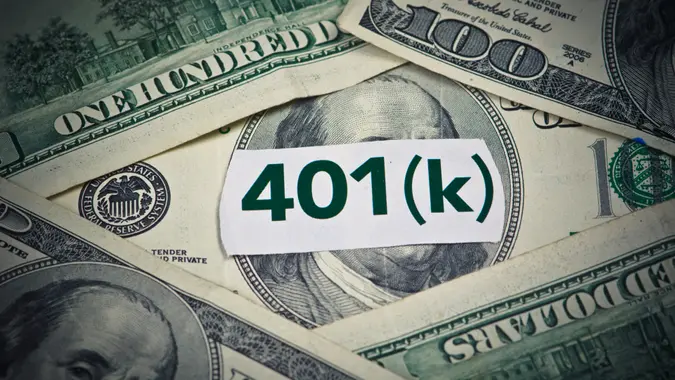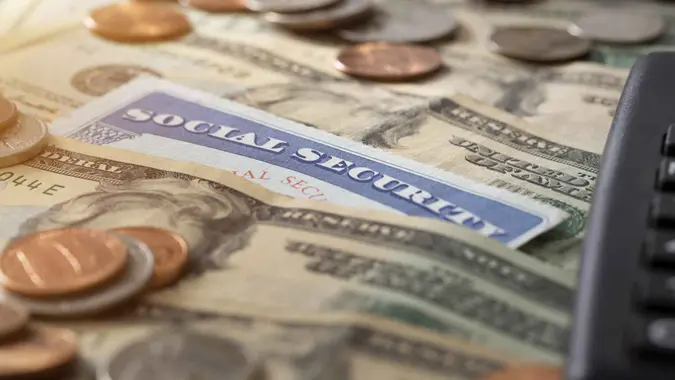401(k) Loan Interest Rate: Rules and Costs Explained

Commitment to Our Readers
GOBankingRates' editorial team is committed to bringing you unbiased reviews and information. We use data-driven methodologies to evaluate financial products and services - our reviews and ratings are not influenced by advertisers. You can read more about our editorial guidelines and our products and services review methodology.

20 Years
Helping You Live Richer

Reviewed
by Experts

Trusted by
Millions of Readers
Borrowing from your 401(k) might sound appealing when you need quick cash. After all, the typical 401(k) loan interest rate is low — usually the prime rate plus 1%, and you’re essentially paying yourself back. But before you borrow, it’s important to understand how these loans work, what they really cost and when they might do more harm than good.
Here’s what you need to know about 401(k) loan interest rates, repayment rules, hidden costs and smarter alternatives.
Quick Facts: 401(k) Loan Interest and Rules
| Feature | Details |
|---|---|
| Typical 401(k) Loan Interest Rate (2025) | Prime rate (7.25%) + 1% = ~8.25% |
| Maximum Loan Amount | 50% of vested balance or $50,000 (whichever is less) |
| Repayment Term | Usually 5 years (longer for a primary home purchase) |
| Repayment Method | Payroll deductions back into your 401(k) account |
| Default Penalty | 10% plus income taxes if not repaid or you leave your job |
| Loan Impact | Lost investment growth and double taxation risk |
Source: IRS, Federal Reserve, Department of Labor
What Is a 401(k) Loan?
A 401(k) loan lets you borrow against your retirement savings and repay the balance — with interest — back into your own account. Unlike a personal loan, there’s no credit check and approvals are often fast.
However, not all plans allow loans, and borrowing reduces your invested balance, which can hurt long-term growth.
How It Works
- You can borrow up to $50,000 or 50% of your vested account balance, whichever is less.
- You’ll repay the loan through automatic payroll deductions, typically over a five-year period.
- If you leave your job, the remaining balance becomes due or it’s treated as a taxable distribution.
A report released in Fidelity’s Q2 2025 retirement analysis indicated that 19.2% of their retirement plan participants had an outstanding 401(k) loan in the second quarter of 2025 — a sign that many use these loans for short-term financial relief.
How 401(k) Loan Interest Rates Are Set
Before borrowing from your retirement account, it’s essential to know how your 401(k) loan interest rate is determined.
Rates are tied to the prime rate and can vary slightly by employer plan, so even a small difference can affect your repayment cost over time.
Typical Formula: Prime + 1%
Most plans set the current 401(k) loan interest rate at the prime rate plus 1%, though some plans charge slightly more.
For example, as of September 2025:
- Prime rate: 7.25%
- Typical 401(k) loan interest rate: 8.25%
That’s far lower than the average credit card rate of 22.8% or a personal loan rate of 11.6%, according to the Federal Reserve.
| Loan Type | Average Interest Rate (2025) |
|---|---|
| 401(k) Loan | 8.25% (Prime + 1%) |
| Personal Loan (24-month avg.) | 11.57% |
| Credit Card | 22.8% |
Pro Tip: Always check your employer’s plan details — some charge prime plus 2%, and not all allow borrowing for every reason.
Repaying Yourself (With a Catch)
One unique feature of a 401(k) loan is that you repay yourself, not a lender. Both principal and interest return to your account, which sounds great — but there’s a caveat:
- You repay with after-tax dollars.
- When you eventually withdraw funds in retirement, you’ll pay taxes again.
That’s what experts call “double taxation” on loan interest.
The Hidden Costs of a 401(k) Loan
While the interest rate seems low, the real costs often show up in opportunity loss and tax impact.
Lost Investment Growth
When you borrow from your 401(k), that money stops compounding in the market. Over the years, that missed growth can outweigh the benefit of a low interest rate.
Example:If you borrow $30,000 for five years at 8.25%, you’ll pay about $6,700 in interest — but that same $30,000 could have grown to nearly $48,000 at a 10% return over the same period.
Double Taxation
Repayments use post-tax dollars, and then withdrawals in retirement are taxed again. So while you “pay yourself,” you’re paying taxes twice on the same money.
Job Risk and Repayment Pressure
If you leave your job — voluntarily or not — you’ll typically need to repay the loan within 60 days. If you can’t, the IRS treats the balance as a taxable withdrawal, plus a 10% early withdrawal penalty if you’re under 59½.
According to a National Bureau of Economic Research (NBER) study, roughly 86% of workers who change jobs default on their 401(k) loans because they can’t repay quickly enough.
The True Cost of a 401(k) Loan vs. Staying Invested
Example: $20,000 Loan at 8.25%
Scenario 5-Year Total Value Outcome Borrow $20,000 via 401(k) Loan (8.25%) $24,332 Repay principal + $4,332 interest Leave $20,000 Invested (10% Annual Return) $32,200 Gain $12,200 in growth Potential Loss in Growth $7,868 Missed compounding over 5 years Source: Calculations based on Federal Reserve prime rate (7.25%) and long-term S&P 500 average return (10%).
Tip: Even if you repay your loan, the lost time in the market often outweighs short-term interest savings.
When a 401(k) Loan Might Make Sense
While generally not ideal, some situations can justify borrowing from your 401(k):
1. Paying Off High-Interest Debt
If you’re facing credit card debt at 20%+ interest, a 401(k) loan at 8.25% could save you thousands in interest — if you repay it on time.
2. Avoiding Predatory Loans
A 401(k) loan is safer than payday or high-fee personal loans. You’re borrowing from your own funds, with no credit check or collateral required.
3. Short-Term Cash Needs With a Clear Repayment Plan
If you’re confident in your job stability and have a short-term expense (like medical bills or home repairs), a 401(k) loan can work — but should be repaid quickly to limit lost growth.
Fidelity’s 2024 Plan Data shows borrowers who repay within two years tend to recover losses faster and maintain long-term retirement growth.
Better Alternatives to a 401(k) Loan
A 401(k) loan isn’t your only option to make your money work smarter for you. Here are some options to consider if borrowing from your retirement isn’t your preferred option:
Home Equity Line of Credit (HELOC)
- Variable interest rates, typically 9% to 10% as of mid-2025
- Interest may be tax-deductible
- Doesn’t impact retirement savings
Personal Loan
- Fixed-rate loans often range from 8% to 12%, depending on credit
- Longer repayment terms (3 to 7 years) than a 401(k) loan
- No risk of triggering retirement penalties
Budget and Cash Flow Adjustments
Before borrowing, consider:
- Reviewing your monthly expenses
- Reducing nonessential spending
- Consolidating or refinancing debt
- Using a free retirement calculator to project long-term impact
A recent survey by the Federal Reserve found that 37% of adults said they could not cover a $400 expense with cash, savings, or a credit card paid off at the next statement. This group would either need to borrow, sell something or would be unable to pay at all, so planning ahead with an emergency fund can prevent the need to tap your 401(k).
Final Take to GO: Weigh the Real Cost Before Borrowing
A 401(k) loan interest rate might look attractive compared to credit cards or personal loans, but the real cost comes from lost growth, double taxation and repayment risk. Before borrowing, run the numbers, consider your job stability and explore all other financing options.
If you’re unsure whether tapping your retirement savings is worth it, talk with a fiduciary financial advisor or use our retirement calculator to see how borrowing might affect your future nest egg.
Last Word: A 401(k) loan should be your last resort, not your first — especially if you’re serious about preserving your retirement wealth.
FAQ
Here are the answers to some of the most frequently asked questions about 401(k) loan interest and how it works:- What is the current 401(k) loan interest rate?
- Most plans charge the prime rate (7.25%) + 1%, or about 8.25% as of 2025.
- How are 401(k) loan interest rates calculated?
- They’re tied to the current prime rate, usually with a 1–2% markup set by your employer’s plan.
- Do I pay myself back with a 401(k) loan?
- Yes -- your payments, including interest, go back into your 401(k) account.
- What happens if I default on a 401(k) loan?
- You’ll owe a 10% penalty plus income taxes if under age 59½, and the loan is treated as a withdrawal.
- Are 401(k) loans better than personal loans?
- Sometimes -- but they carry more risk. If you lose your job, you could owe taxes and penalties immediately.
Information is accurate as of Oct. 22, 2025.
Our in-house research team and on-site financial experts work together to create content that’s accurate, impartial, and up to date. We fact-check every single statistic, quote and fact using trusted primary resources to make sure the information we provide is correct. You can learn more about GOBankingRates’ processes and standards in our editorial policy.
- U.S. Federal Reserve "Report on the Economic Well-Being of U.S. Households in 2024 - May 2025"
- Fidelity "Q1 2024 Retirement Analysis"
- National Bureau of Economic Research "The Bulletin on Ageing and Health"
- IRS "Retirement topics - Plan loans"
- Fidelity "Q2 2024 Retirement Analysis"
 Written by
Written by  Edited by
Edited by 

























